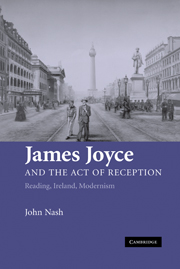Book contents
- Frontmatter
- Contents
- List of figures
- Acknowledgements
- Textual note
- Introduction: writing reception
- 1 Boredom: reviving an audience in Dubliners
- 2 Surveillance: education, confession and the politics of reception
- 3 Exhaustion: Ulysses, ‘Work in Progress’ and the ordinary reader
- 4 Hypocrisy: Finnegans Wake, hypocrites lecteurs and the Treaty
- Afterword
- Notes
- Bibliography
- Index
1 - Boredom: reviving an audience in Dubliners
Published online by Cambridge University Press: 22 September 2009
- Frontmatter
- Contents
- List of figures
- Acknowledgements
- Textual note
- Introduction: writing reception
- 1 Boredom: reviving an audience in Dubliners
- 2 Surveillance: education, confession and the politics of reception
- 3 Exhaustion: Ulysses, ‘Work in Progress’ and the ordinary reader
- 4 Hypocrisy: Finnegans Wake, hypocrites lecteurs and the Treaty
- Afterword
- Notes
- Bibliography
- Index
Summary
It might be said of Joyce, as is said of Jimmy Doyle in ‘After the Race’, that he ‘felt obscurely the lack of an audience’ (D 41). In writing his early stories, of course, Joyce had few readers to draw upon: what readers he had at this stage were, mostly, a private rather than a public readership, such as those who had received his hand-delivered satirical verse, ‘The Holy Office’. This lack of an audience – indeed, its impossibility – is one of the principal preoccupations of Joyce's work. Such a lack would remain with him throughout his career as, paradoxically, one of the constituent characteristics of reception: whereas his work refers to particular readers and scenes of reading, it is unwilling to foresee an audience for itself. Unlike Yeats, for instance, who at various points imagined differing visions of an ideal audience, Joyce refuses the possibility of this prospect. Instead, a dual concern with the need for readers, but also an unwillingness to write for a readership, can be detected in Joyce's work from the earliest stages.
Although Joyce shared many of the concerns and even some of the aims of revivalist writers such as Yeats and Synge especially, his well-known estrangement from both the Abbey and the Gaelic League, as well as from both the Anglo-Irish establishment and the Catholic hierarchy, presented formidable barriers to securing a readership.
- Type
- Chapter
- Information
- James Joyce and the Act of ReceptionReading, Ireland, Modernism, pp. 28 - 61Publisher: Cambridge University PressPrint publication year: 2006



